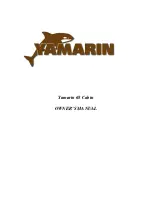
MAINTENANCE
PAGE 28
CLEANING FIBERGLASS SURFACES
Fiberglass surfaces should be cleaned
regularly. Normal accumulations
of
surface dirt can be removed simply by
occasional rinsings with water. If you
operate your boat in salt water, more
frequent rinsing will be required. To
remove stubborn dirt, grease or oil, use
a mild detergent and a soft brush. Rinse
with fresh clean water. Avoid the
plexiglass
companionway
slider,
windshield, deck hatches and fixed ports
when using a deck brush, since these
surfaces can scratch.
It is a good idea to wax the fiberglass
once or twice a year to maintain a deep,
glossy appearance. Your local marine
supply should be able to provide an
appropriate wax.
EXPLOSION/FIRE HAZARD
Cleaning agents and paint ingredients
may be flammable and/or explosive,
and dangerous to inhale. Be sure to use
adequate ventilation, and appropriate
safety clothing (gloves, safety glasses,
respirator, etc.)
CLEANING ACRYLIC
Use only mild soap and water to clean
acrylics. Do not use products containing
solvents such as ammonia, which is
found in many window cleaners.
Use care when cleaning acrylic.
Dry cloth and many glass
cleaners will scratch. Solvents
will attack the surface.
SAIL CARE
Sunlight is a sail
’
s worst enemy, so
cover
the mainsail when not in use.
An
ultraviolet guard, fitted down the leech of a
roller headsail will protect the exposed part
from the weathering effect of the sun and
from dirt and grit.
Mildew, can be prevented by storing sails
dry and by hand washing twice a season.
Check
all
sails
regularly
for
chafe,
particularly where they chafe on deck fittings
or rigging, at reef points, batten sleeves and
the foot of the headsail. Sail batten pockets
should be inspected on a regular basis.
To stow the mainsail, start at the leech and
flake it onto the boom, left and right, in about
18-in. (46 cm) folds, while pulling the leech
aft. Secure with a sail tie and continue to the
luff. Lash to the boom with sail ties or shock
cord.
GENERAL HARDWARE MAINTENANCE
Check all fittings regularly to be sure
screws are tight. Occasionally lubricate
(use silicone lubricants) all moving parts
on such fittings as blocks, turnbuckles
and cam cleats, as well as the locking
pins of snatch blocks, track slides,
spinnaker poles, etc. Inspect cleat and
fairleads for roughness and smooth with
fine-grained emery paper if necessary.
Also, replace any missing or damaged
cotter pins in turnbuckles and shackles,
and either tape them or use them or use
protective covers manufactured for that
purpose. Grease winches a minimum of
once yearly.
WINCH MAINTENANCE
Follow the maintenance instructions
prescribed by winch manufacturer.
We recommend a minimum of an
annual cleaning and light greasing.
Summary of Contents for 44DS
Page 28: ......
Page 39: ......
Page 40: ......
Page 41: ......
Page 43: ......
Page 45: ......
Page 46: ......
Page 47: ......
Page 50: ......
Page 52: ......
Page 53: ......
Page 54: ......
Page 55: ......
Page 56: ...43B 4268043B ENG NONE ...
Page 57: ...44A ...
Page 58: ...44B ...
Page 73: ...51 4268051 ENG NONE ...
Page 76: ......
Page 77: ......
Page 78: ......
Page 79: ......
Page 80: ......
Page 82: ......
Page 84: ......
Page 85: ......
Page 86: ......
Page 88: ......
Page 89: ...59B 4268059B ENG NONE ...
Page 90: ......
Page 91: ......
Page 92: ......
Page 93: ......
Page 95: ...60C 4268060C ENG NONE ...
Page 96: ......
Page 97: ......
Page 101: ......
Page 105: ......
Page 110: ......
Page 113: ......
Page 114: ......
Page 117: ......
Page 118: ......
Page 120: ......
Page 123: ......
Page 124: ......
Page 125: ......
Page 126: ......
Page 127: ......
Page 130: ......
Page 132: ......
Page 133: ......
Page 135: ......
Page 137: ......
Page 141: ......
Page 142: ......
Page 145: ......
Page 148: ......
Page 149: ......
Page 150: ......
Page 154: ......
Page 156: ......
















































